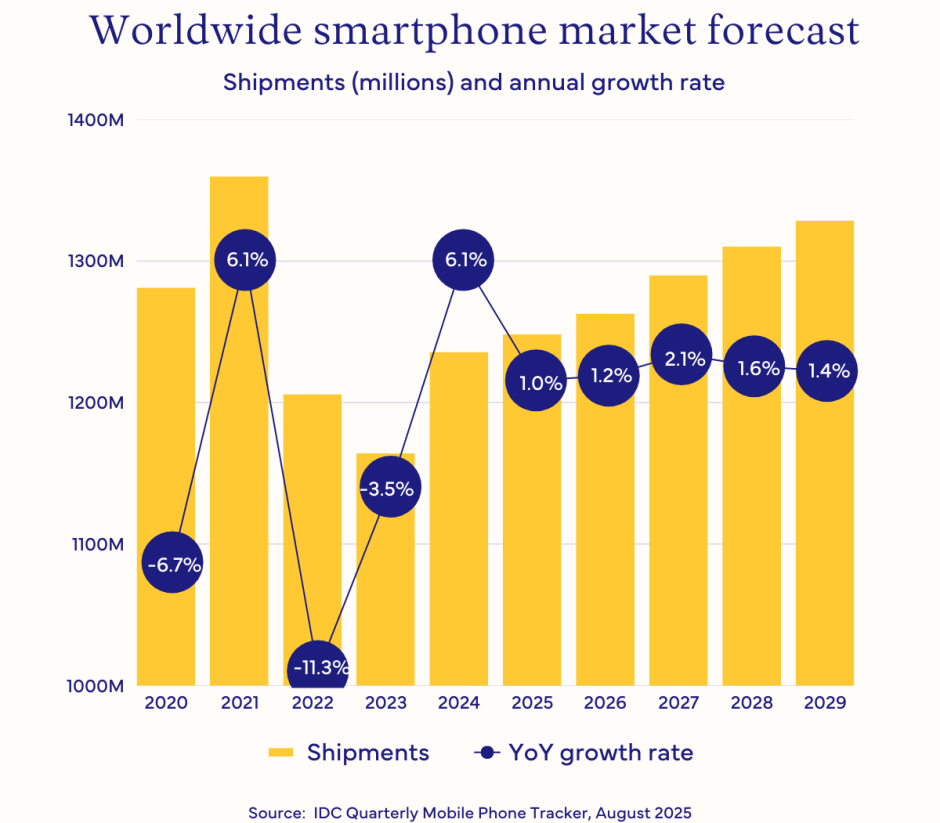The global smartphone market is showing cautious optimism as shipments are forecast to grow 1.0 percent in 2025, reaching 1.24 billion units, according to IDC report.

This marks an improvement from IDC’s previous forecast of 0.6 percent, largely driven by 3.9 percent growth in iOS devices. Despite challenges like soft demand and economic uncertainties, healthy replacement demand is expected to sustain growth, leading to a compound annual growth rate (CAGR) of 1.5 percent from 2024 to 2029.
The total addressable market (TAM) has slightly increased, supported by a current U.S. government exemption on smartphone tariffs, insulating vendors from additional costs that could have negatively impacted shipments.
Despite ongoing tariff uncertainties, smartphone vendors are largely unaffected for now, but OEMs need to continue diversifying production and supply chains to meet strong demand in key markets, Nabila Popal, Senior Research Director, IDC, said.
Regional Growth Patterns to Watch
Regional performance will vary in 2025:
U.S.: 3.6 percent growth
Middle East & Africa (MEA): 6.5 percent growth
Asia Pacific excluding China (APeC): 0.8 percent growth
China: 1 percent decline
China’s slowdown in smartphone market is attributed to phasing out government subsidies and ongoing economic challenges, which have reduced the forecast from 3 percent growth. For OEMs, identifying pockets of opportunity in high-growth regions will be critical to maintain global competitiveness.
Shift from Volume to Value
Even though unit growth remains modest at 1 percent, the smartphone market is experiencing a robust 5 percent YoY growth in average selling price (ASP) and 6 percent growth in market value. Vendors are focusing on premiumization strategies by investing in innovative hardware — slimmer designs, foldable devices, advanced camera systems, and on-device GenAI features — to attract consumers willing to pay more for high-end devices. Promotions, interest-free financing, and trade-in programs are also making premium devices more accessible.
GenAI is becoming a key differentiator for smartphone vendors, with 370 million GenAI-enabled phones expected in 2025 (30 percent market share). As adoption grows and consumers become more familiar, even mid-range devices will integrate GenAI, potentially reaching over 70 percent market share by 2029, Anthony Scarsella, Research Director, IDC, said.
Foldable Smartphones: Moving Toward Mainstream
Foldable smartphones are entering a growth phase, with shipments expected to rise 6 percent YoY in 2025, up from 4 percent in 2024. IDC predicts continued acceleration with 6 percent growth in 2026 and 11 percent in 2027. Advances in durability, design, and pricing are helping reduce adoption barriers, although foldables are projected to remain a niche segment, representing less than 3 percent of total smartphone shipments by 2029.
Recent hardware and software improvements from top brands such as Samsung, Google, Motorola, Honor, and Huawei indicate that the foldable smartphone category is maturing and gaining wider acceptance, Francisco Jeronimo, VP, Client Devices, IDC, said.
Key Takeaways for Vendors and Consumers
For Smartphone Vendors:
Focus on premiumization and value growth rather than solely chasing volume.
Leverage GenAI and foldable technologies to differentiate products.
Identify high-growth regions (U.S., MEA, APeC) for targeted investments.
Plan production and supply chain diversification to navigate tariff uncertainty.
For Consumers:
Expect more feature-rich mid-range devices with AI capabilities in the coming years.
Premium devices and foldables are becoming more accessible through financing programs.
Technology trends like GenAI integration, advanced cameras, and foldable form factors will continue to drive device innovation.
Conclusion
The smartphone market in 2025 is navigating a mixed landscape of soft unit growth but rising value and innovation. OEMs that focus on regional opportunities, premiumization, and emerging technologies like GenAI and foldables will be best positioned for success. Meanwhile, consumers can anticipate smarter, more versatile devices as vendors push the boundaries of innovation and affordability.
Baburajan Kizhakedath
